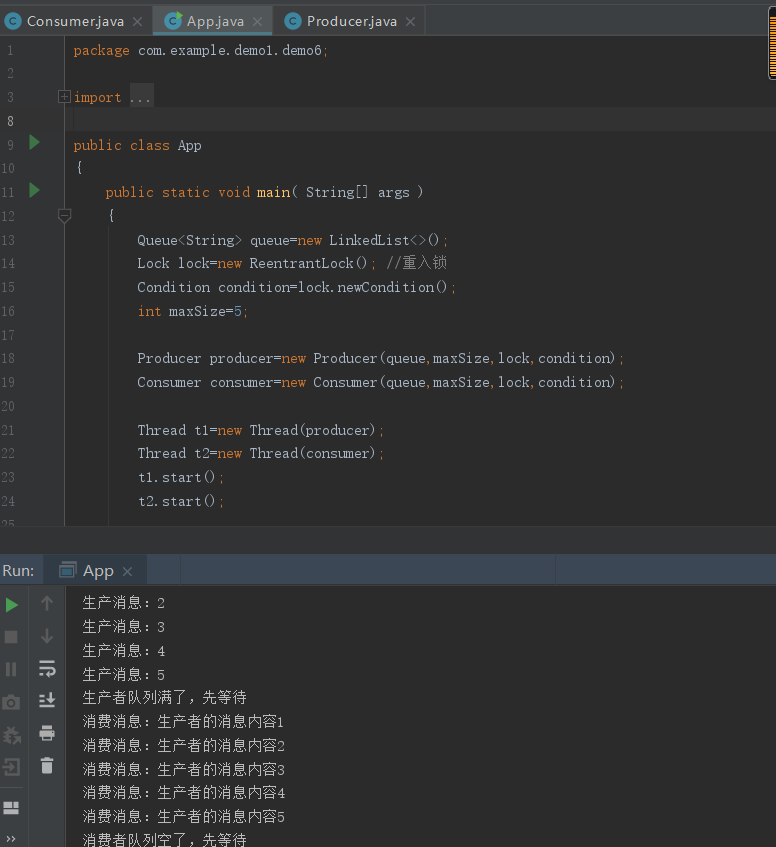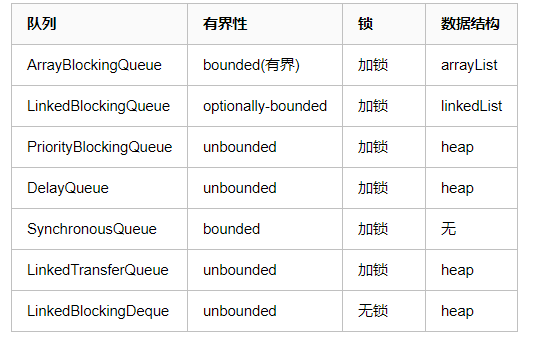一.Condition 的基本使用
和以前一样,开篇先用一个例子来演示,我们就拿以前写的wait/notify的例子结合Lock进行改造下
public class Producer implements Runnable{
private Queue<String> msg;
private int maxSize;
Lock lock;
Condition condition;
public Producer(Queue<String> msg, int maxSize, Lock lock, Condition condition) {
this.msg = msg;
this.maxSize = maxSize;
this.lock = lock;
this.condition = condition;
}
@Override
public void run() {
int i=0;
while(true){
i++;
lock.lock();
while(msg.size()==maxSize){
System.out.println("生产者队列满了,先等待");
try {
condition.await(); //阻塞线程并释放锁
} catch (InterruptedException e) {
e.printStackTrace();
}
}
try {
Thread.sleep(1000);
} catch (InterruptedException e) {
e.printStackTrace();
}
System.out.println("生产消息:"+i);
msg.add("生产者的消息内容"+i);
condition.signal(); //唤醒阻塞状态下的线程
lock.unlock();
}
}
}
public class Consumer implements Runnable{
private Queue<String> msg;
private int maxSize;
Lock lock;
Condition condition;
public Consumer(Queue<String> msg, int maxSize, Lock lock, Condition condition) {
this.msg = msg;
this.maxSize = maxSize;
this.lock = lock;
this.condition = condition;
}
@Override
public void run() {
int i=0;
while(true){
i++;
lock.lock(); //synchronized
while(msg.isEmpty()){
System.out.println("消费者队列空了,先等待");
try {
condition.await(); //阻塞线程并释放锁 wait
} catch (InterruptedException e) {
e.printStackTrace();
}
}
try {
Thread.sleep(1000);
} catch (InterruptedException e) {
e.printStackTrace();
}
System.out.println("消费消息:"+msg.remove());
condition.signal(); //唤醒阻塞状态下的线程
lock.unlock();
}
}
}

有了以前篇幅的介绍,我们现在应该很清楚lock.lock();做了啥事情,下面我们就condition.await();做了啥事情分析下,进入 condition.await();方法;
public final void await() throws InterruptedException {
if (Thread.interrupted())
throw new InterruptedException();
//有Node我第一个想到的节点,这段代码其实就是构造一个Condition的队列,我们可以点击进去分析下
Node node = addConditionWaiter();
//解决重入问题,跟进代码看下
int savedState = fullyRelease(node);
int interruptMode = 0;
while (!isOnSyncQueue(node)) {
LockSupport.park(this);
if ((interruptMode = checkInterruptWhileWaiting(node)) != 0)
break;
}
if (acquireQueued(node, savedState) && interruptMode != THROW_IE)
interruptMode = REINTERRUPT;
if (node.nextWaiter != null) // clean up if cancelled
unlinkCancelledWaiters();
if (interruptMode != 0)
reportInterruptAfterWait(interruptMode);
}
private Node addConditionWaiter() {
//lastWaiter表示最后一个等待节点,我们看在ConeitionObject类可以发现其实他定义了一个首节点和一个尾节点分别是firstWaiter和lastWaiter;
Node t = lastWaiter;
//刚刚初始化时t一定是空的
// If lastWaiter is cancelled, clean out.
if (t != null && t.waitStatus != Node.CONDITION) {
//判断是否是偏锁状态
unlinkCancelledWaiters();
t = lastWaiter;
}
//构造一个Node节点,传的是当前线程,当前线程表示的是获得锁的线程,CONDITION是一个条件队列;这里面New Node()和我们上一篇幅讲的一样会初始一个waitStatus值,初始值是0
Node node = new Node(Thread.currentThread(), Node.CONDITION);
if (t == null)
firstWaiter = node;
else
t.nextWaiter = node;
lastWaiter = node;
return node;
}
final int fullyRelease(Node node) {
boolean failed = true;
try {
//得到state值
int savedState = getState();
//进入判断的relelase方法会发现这是一个释放锁的过程;释放完成后他会叫醒阻梗的线程
if (release(savedState)) {
failed = false;
return savedState;
} else {
throw new IllegalMonitorStateException();
}
} finally {
if (failed)
node.waitStatus = Node.CANCELLED;
}
}
走到这一步阻塞的队列就会唤醒,新的线程会重新走await方法
public final void await() throws InterruptedException {
if (Thread.interrupted())
throw new InterruptedException();
//有Node我第一个想到的节点,这段代码其实就是构造一个Condition的队列,我们可以点击进去分析下
Node node = addConditionWaiter();
//解决重入问题,跟进代码看下
int savedState = fullyRelease(node);
int interruptMode = 0;
//判断节点在不在AQS同步队列中
while (!isOnSyncQueue(node)) {
//如果不在同步队列中就可以挂起了
LockSupport.park(this);
if ((interruptMode = checkInterruptWhileWaiting(node)) != 0)
break;
}
if (acquireQueued(node, savedState) && interruptMode != THROW_IE)
interruptMode = REINTERRUPT;
if (node.nextWaiter != null) // clean up if cancelled
unlinkCancelledWaiters();
if (interruptMode != 0)
reportInterruptAfterWait(interruptMode);
}
上面的阻塞过程讲解完了下面说下唤醒机制是怎么做的,我们进入condition.signal();
public final void signal() {
if (!isHeldExclusively())
throw new IllegalMonitorStateException();
//获取头部节点,此时头部节点是在Condition队列中等待被唤醒的头部节点,唤醒后会移到AQS队列中去抢占锁(因为condition队列是等待队列,AQS队列是抢占锁队列)
Node first = firstWaiter;
if (first != null)
//头节点不会为空所以进入下面方法
doSignal(first);
}
private void doSignal(Node first) {
do {
//条件成立说明当前的Condition队列中没有阻塞的线程了
if ( (firstWaiter = first.nextWaiter) == null)
//节点清空
lastWaiter = null;
//断掉唤醒的节点和等待唤醒的节点间的指向引用
first.nextWaiter = null;
} while (!transferForSignal(first) &&
(first = firstWaiter) != null);
}
final boolean transferForSignal(Node node) {
/*
* If cannot change waitStatus, the node has been cancelled.
*/
//如果是偏锁状态说明这个节点是有问题的,没必要进行抢占锁,直接断掉引用进行回收
if (!compareAndSetWaitStatus(node, Node.CONDITION, 0))
return false;
/*
* Splice onto queue and try to set waitStatus of predecessor to
* indicate that thread is (probably) waiting. If cancelled or
* attempt to set waitStatus fails, wake up to resync (in which
* case the waitStatus can be transiently and harmlessly wrong).
*/
//将当前节点移到AQS队列中去,从condition等待队列中移除
Node p = enq(node);
int ws = p.waitStatus;
//如果ws>0表示是偏锁状态,如果是偏锁状态就唤醒
if (ws > 0 || !compareAndSetWaitStatus(p, ws, Node.SIGNAL))
LockSupport.unpark(node.thread);
return true;
}
二.阻塞队列的成员

下面分别简单介绍一下:
-
ArrayBlockingQueue:是一个用数组实现的有界阻塞队列,此队列按照先进先出(FIFO)的原则对元素进行排序。支持公平锁和非公平锁。【注:每一个线程在获取锁的时候可能都会排队等待,如果在等待时间上,先获取锁的线程的请求一定先被满足,那么这个锁就是公平的。反之,这个锁就是不公平的。公平的获取锁,也就是当前等待时间最长的线程先获取锁】
-
LinkedBlockingQueue:一个由链表结构组成的有界队列,此队列的长度为Integer.MAX_VALUE。此队列按照先进先出的顺序进行排序。
-
PriorityBlockingQueue: 一个支持线程优先级排序的无界队列,默认自然序进行排序,也可以自定义实现compareTo()方法来指定元素排序规则,不能保证同优先级元素的顺序。
-
DelayQueue: 一个实现PriorityBlockingQueue实现延迟获取的无界队列,在创建元素时,可以指定多久才能从队列中获取当前元素。只有延时期满后才能从队列中获取元素。(DelayQueue可以运用在以下应用场景:1.缓存系统的设计:可以用DelayQueue保存缓存元素的有效期,使用一个线程循环查询DelayQueue,一旦能从DelayQueue中获取元素时,表示缓存有效期到了。2.定时任务调度。使用DelayQueue保存当天将会执行的任务和执行时间,一旦从DelayQueue中获取到任务就开始执行,从比如TimerQueue就是使用DelayQueue实现的。)
-
SynchronousQueue: 一个不存储元素的阻塞队列,每一个put操作必须等待take操作,否则不能添加元素。支持公平锁和非公平锁。SynchronousQueue的一个使用场景是在线程池里。Executors.newCachedThreadPool()就使用了SynchronousQueue,这个线程池根据需要(新任务到来时)创建新的线程,如果有空闲线程则会重复使用,线程空闲了60秒后会被回收。
-
LinkedTransferQueue: 一个由链表结构组成的无界阻塞队列,相当于其它队列,LinkedTransferQueue队列多了transfer和tryTransfer方法。
-
LinkedBlockingDeque: 一个由链表结构组成的双向阻塞队列。队列头部和尾部都可以添加和移除元素,多线程并发时,可以将锁的竞争最多降到一半。